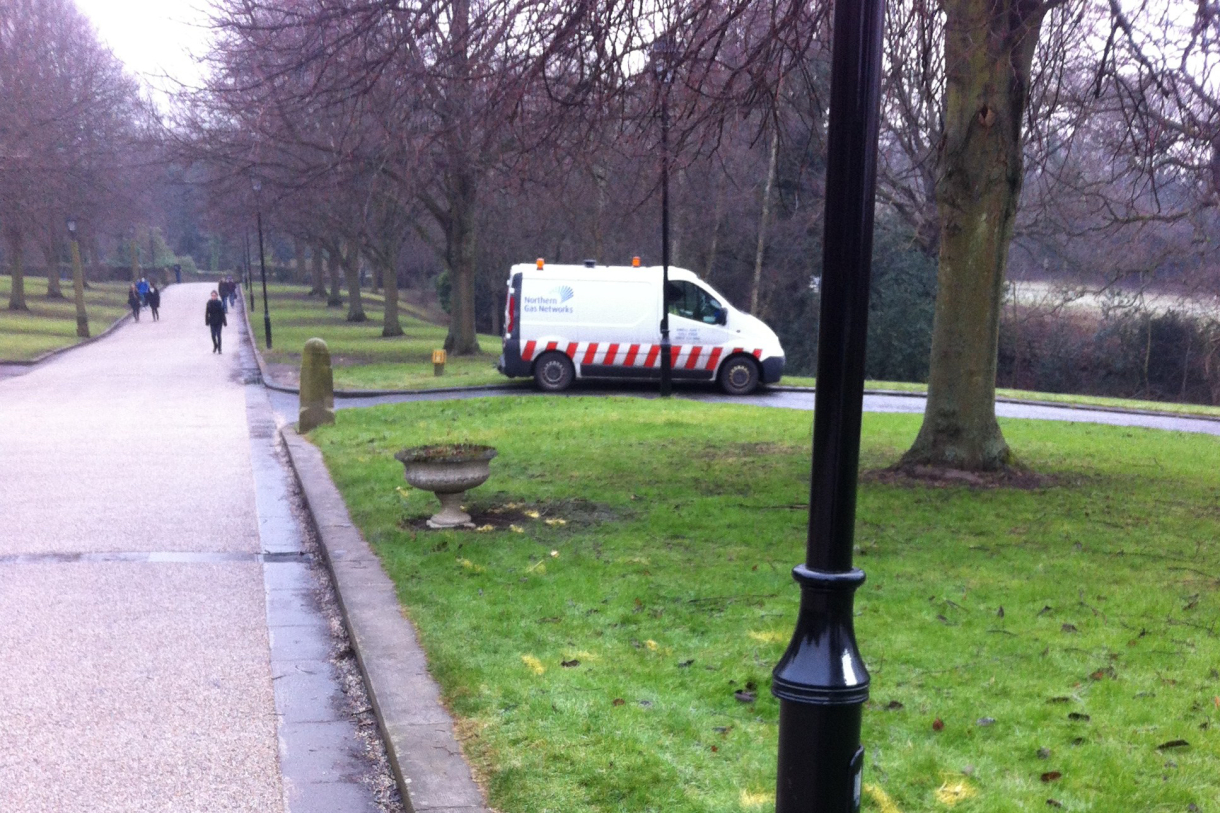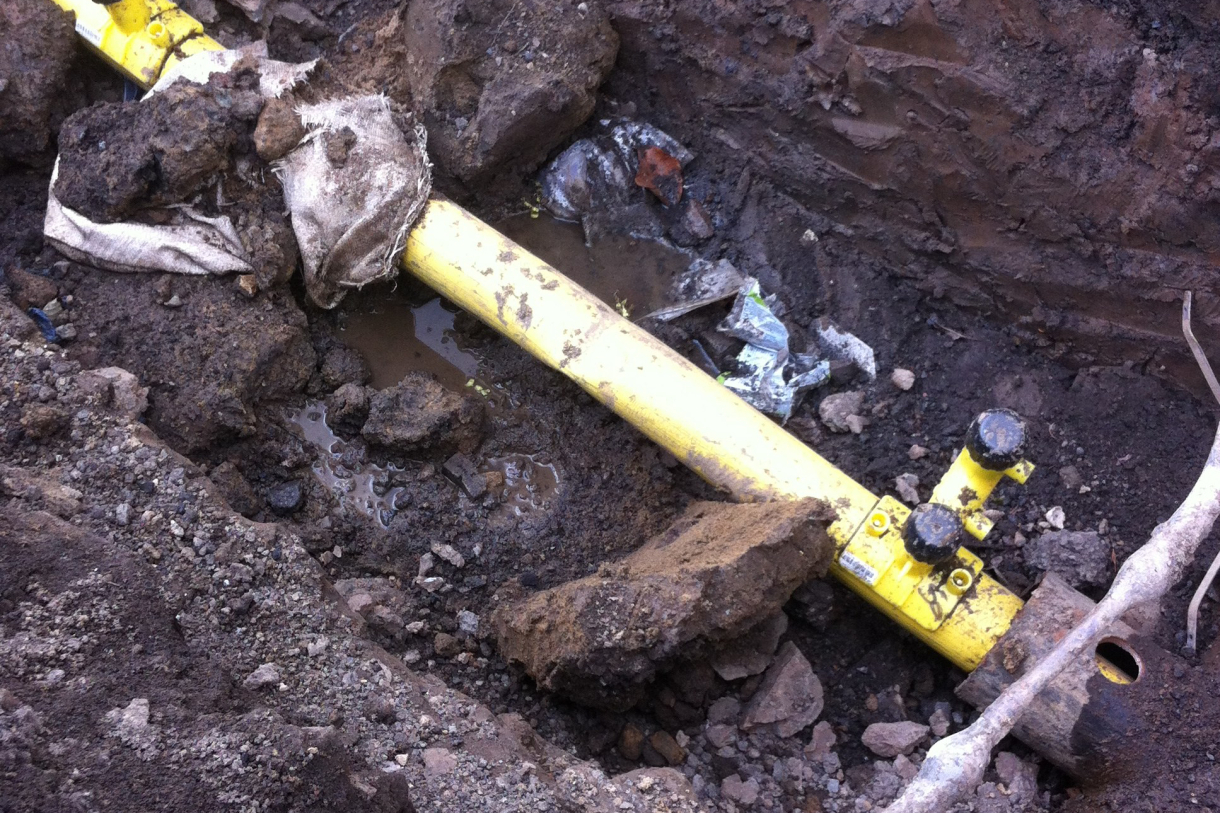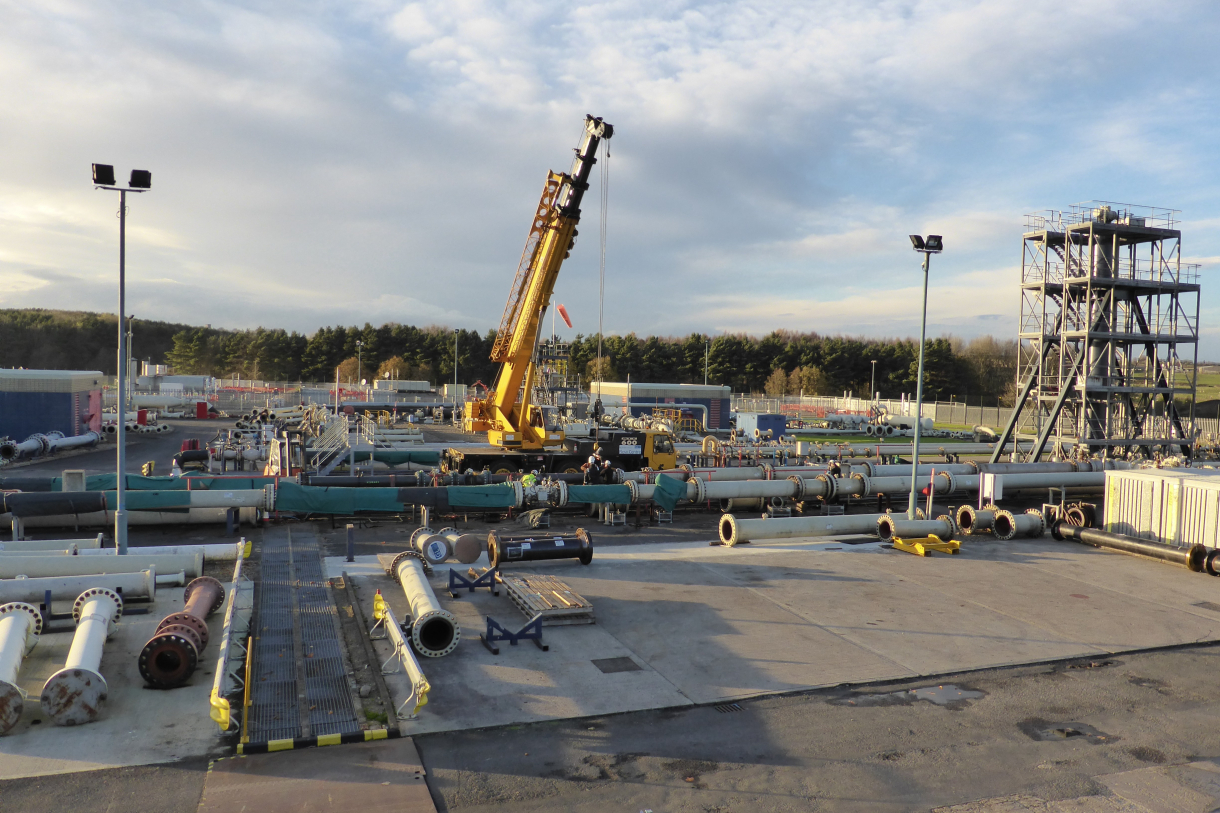
followthethings.com
Home & Auto
“Hard To Follow Things: Natural Gas“
A blog post by Peter Forman originally published on the followthethings.com blog.
Available in full below. Originally published here.
PhD student Peter Forman wants to follow the thing, but his thing is natural gas. That’s a difficult thing to follow. Most of the things that people follow could be held in their hand, placed in their shopping bag. But it’s difficult and dangerous to do that with gas. Most of the things that people follow clearly come from somewhere. This banana was grown in this country. This phone was assembled in that country. But natural gas molecules from different sources get mixed up, so you can’t follow this commodity from source to destination, from production to consumption. It also gets from A to B underground, along pipes whose exactly network is a closely guarded secret. So how do you follow gas? For Peter, you find the places where it comes to the surface, in infrastructure, where it leaks, where the gas company vans and workers are digging holes, mending and replacing piping, that kind of thing. Thing-followers know that their thing is going to be a co-author of their work. It’s going to shape the way they work, and how they can study it. Nothing is impossible to follow, you just need some creative thinking, theorising and fieldwork strategies to work it out. As Peter says a the end of his post, ‘Every “thing” introduces its own challenges for study, and as thing-followers, we must be attentive to these specificities, continue to develop novel strategies for dealing with these difficulties, and continue to share our experiences of the challenges encountered.’ He’s sharing his experiences below.
Page reference: Pete Forman (2024) Hard To Follow Things: Natural Gas. followthethings.com/hard-to-follow-things-natural-gas.shtml (last accessed <insert date here>)
Estimated reading time: 14 minutes.
Introduction
Natural gas can be thought of as natural in two senses of the word. First, it forms deep beneath the ground, independently of human action (as opposed to the manufactured gas that was used in the UK before 1970 – this gas was the product of hard labour, workers feeding iron retorts with coal), and second, it is naturalised. Whilst gas plays a crucial role in many people’s daily lives – we heat our homes with it, cook with it, and use it to warm water for bathing comfortably – most of us never give it much consideration. We come home from work, twist the tap on the hob, give it a press, then click! A spark. An eruption of yellow-blue flame. It is there, ready and waiting. It provides heat in an instant and is worthy of no further thought.
Yet in other ways, ‘natural gas’ is far from natural. Its presence beneath the earth is made knowable through a multitude of technologically complex devices, and it is only through the deployment of established knowledges, bodies and technological instruments that it is securely extracted, processed, pressurised, transported, and consumed. This is what Bridge (2004; 396) refers to when he describes how “a whole industry has emerged … dedicated to corralling the waywardness and variability of gas and rendering it a commodity compliant with the workings of the market”. Indeed, it is as a consequence of this dense assemblage that we can understand gas to not simply be there, ready and waiting. Far from it! For without the practices of these diverse actors, it would remain deep beneath our feet, trapped between layers of rock. As it travels (the direction and nature of which is likewise defined by said actors), it could also come to realise a series of what Dillon and Reid (2001) call ‘dimensions of dangerousness’. From it realising its flammability and explosiveness, to it causing significant societal disruption through the interruption of its supply, or it having severe ecological impacts of different kinds (for example, affecting global climate or contributing to marine crises such as in Puchuncavi, Chile – see Tironi et al. 2018), across its travels, natural gas can come to present a series of dangers that generate myriad attempts to perform security around it.
As enthusiastic ‘thing followers’, it is our job to map out entities’ naturalised associations and the political situations that develop across their journeys. This is the focus of my current research around natural gas, in which I try to trace the different ways in which concerns for security develop as this gas travels across the UK. I map the emergent relations that provoke different security concerns, and document the multiplicity of techniques employed to either nullify or mitigate against different kinds of perceived gaseous threat. Indeed, given gas’s role in myriad ecologies and the dangers its circulation brings into everyday social environments, gas provides a fascinating subject of study for like-minded thing-followers. Yet as I found in this work, almost as fascinating as the dangers that are associated with its travel are the methodological challenges it presents for trying to follow it. It is these challenges that I wish to explore in the remainder of this post.
Challenge 1: Following a Material that Defies Human Senses
The first methodological challenge regards the inability of humans to naturally sense natural gas. In its raw form, natural gas is typically odourless, invisible, intangible and tasteless. These properties make it very difficult to know if and when the gas is present, in what volumes, how it is moving, and what its possible actions are. As a consequence, a vast number of technological instruments have been developed (from gas detectors and pressure sensors to artificial odourants) to either supplement human senses or to alter the gas in ways that render its movements humanly sensible.
Such technologies have little value for social scientists if the data produced through them is kept under wraps, however. Given the UK’s dependency on gas, the data/control systems used to monitor, govern and maintain gas supply are the focus of restrictions that limit their accessibility to external parties. Furthermore, whilst the gas in the lower pressure gas networks is odourized and is therefore potentially sensible to researchers’s bodies, this smell is only useful when the gas has escaped. Until this point, researchers are able to glean very little about its subterranean movements.
So how then do we go about following this troublesome material? Luckily for us, the pipes surrounding and transporting gas offer a partial answer, serving as a proxy for the gas’s movements. Wherever there is a pipe, we can reasonably assume that gas will also be there. Following gas would therefore appear to be a simple matter of following pipes.
Moreover, in instances where gas comes to circulate beyond pipes (when it escapes), the vibrancy and vocality of this material (see Bennett 2010; Daston 2007) means that it often necessitates the rapid deployment of other actors around the location of its release. Indeed, it is remarkably effective at drawing around itself a large community of concerned actors, an agency that can be extremely useful for observing its movements. Locating, watching and interrogating these actors can reveal details of the kinds of gaseous agency that are anticipated and feared; the attempts made to visualise its extra-infrastructural movements; and the ways in which these movements are (or are not) brought under control. Site visits to locations of gas’s escapes therefore provided one means through which to carry out these kinds of observations, and accordingly, the site visit became one of the key methods of my research. Indeed, given the strength of these actors’ responses to leaks, even instances where gas leaks were known to occur but did not generate such responses were analytically interesting for they invited the question: why have these escapes not solicited similar kinds of response?
Challenge 2: Convoluted Circulations
The second set of challenges presented by the gas concerned the convolution of its circulations. This effectively boils down to a question of what it is we are actually following. Is it specific molecules? Is it particular volumetric ‘packages’ of gas? Is it a wave of pressure that moves within pipes? Dependent on the answer to these questions, different problems arise for how we follow it. For instance, gas comes into the UK gas transport infrastructure at numerous sites (coastal processing terminals, private storage facilities, biomethane plants) and also arrives in the UK from a large number of different sources (US liquefied natural gas, piped gas from the North Sea, from Russia, and from biomethane production facilities on the UK mainland). As it enters the system, it mingles with gas molecules/packets/batches from other sources, meaning that following any one unit is extremely difficult, if not impossible. In this sense, it is like Brett Christopher’s money, in that it is a thing that loses its ‘distinguishability’ as it circulates (2011; 1076).
The solution arrived at in this project was to interrogate the ways in which the actors involved in governing gas themselves visualised and followed gas’s circulations. Whilst I was rarely allowed direct access to measurement data, practitioners were often happy to describe the ways that gas flows are measured, and frequently provided me with documents on the instruments employed across these networks. Interviewing and documentary analysis thus provided the principle means through which to address such questions.
The result of these investigations was ultimately that following individual gas molecules, voluminous packets or batches of gas was not considered important for understanding how security is performed in relation to these flows. As my principal concern was with the kinds of practices of security that are employed upon gas across its circulations, I subsequently found that it was possible to identify many of these practices by just following the pipes. By observing the actors and practices that presented themselves along the way, I was able to observe specific forms of action that were taken upon the gas as it travelled.
Despite this, I did have to carefully watch out for instances where gas’s governing actors did seek to visualise volumes of gas as they circulated. If it became apparent that gas was managed at the level of molecules, particular volumes, or pockets of gas, then it would become necessary to follow these units and ascertain when and how they became the focus of security concerns. During fieldwork however, it quickly became apparent that gas is principally managed according to its pressures in different parts of these systems, and it is not tracked by its governing actors on a molecule-by-molecule (or even volume-by-volume) basis. This is not to say that its movement at the level of the molecular or volumetric was not significant for the practices of security observed to surround it – for example, there were moments when it was broken down into its constitutive molecules (such as during chemical processing), but these units were never followed along their circulatory journeys beyond such points of inspection. As such, it was not considered necessary to identify and follow any one particular molecule or volume in order to develop an account of security’s practice.
The management of gas’s circulation by pressure did introduce a secondary problem, however. Gas’s journeys turned out to be extremely convoluted, and unlike a bottle of hot pepper sauce (which might make its way from point of production to point of consumption in a more-or-less linear manner), natural gas was found to be able to take any one of potentially thousands of routes between its points of production and consumption, and along these routes, to not necessarily move in a linear trajectory. Because it travels from regions of high pressure to areas of low pressure, and this movement is manipulated by increasing its pressure at particular locations, and then lowering it at others (typically through its consumption or release), gas may travel both backwards and forwards along the same pipes. Whilst this is interesting due to the way that it challenges implicit assumptions of the linearity of circulatory governance found in many studies of security – including the work of Foucault (2007), it raised further challenges for fieldwork, due to how gaseous security practices could not be simply documented by linearly following pipes from one end to another – both because the gas moved back and forth, and because of the vast geographical spread of these subterranean infrastructures.
Challenge 3: Gas’s Subterranean Concealment
Moreover, despite pipes acting as a proxy for gas circulations, following them is often not as simple as it sounds. The vast majority are buried beneath the surface. As Ackroyd (2012) describes, the ground serves two functions here: it hides pipes from view, cognitively distancing them from actors intent on damaging them, and it also provides a physical layer of defence that protects them from most forms of accidental damage.
The consequence is that the only times when it was easy to directly observe gas pipes and the actors around them was when they were excavated for maintenance. In these cases, site visits were again employed to explore the associations that developed around the gas at those locations. Yet there were two particularly pertinent issues that still arose from these methods: first, that gas’s associations could only be traced in these particular locations, under very specific circumstances, and second, that I could not go anywhere near excavated high pressure gas pipes due to health and safety restrictions (access to low pressure pipeline repair sites was not restricted, due to the gas presenting lower risks to health).
As a result, observing the emerging relations that develop around gas’s ‘normal’ travels beneath the earth could not be achieved through these methods. Moreover, given the gas industry’s desire to conceal the location of its pipelines, the circulation of precise maps of the layout of these infrastructures was restricted. As a consequence, directly following these pipes and their associations from above ground was rarely possible. Even if they were, many of the above-ground sites of gas’s journeys across the UK are classified as sites of ‘Critical National Infrastructure’, and this means that additional security practices are conducted around gas’s movements in these locations – some of which I had the discomfort of witnessing first hand(fn).
As such, we can observe a series of techniques employed to prevent inquisitive parties from learning the details of gas’s circulations and the forms of danger associated with them. As a thing-follower, mapping the associations that develop within such highly securitised infrastructures is therefore extremely difficult, for researchers can appear to potentially undermine the securing work done to obscure and conceal gas circulations, and may become regarded as sources of risk, our outputs having the potential to be used for malicious purposes.
The solution arrived at in this project was to first identify as many actors that became involved with the circulation of gas as possible via online research, and to then contact and organise interviews with representatives from these parties to learn about the nature of their relationships with the gas, and to inquire about other actors known to be involved with the gas across its travels. Key to this process was to convince these actors that my work presented minimal security risks. This often involved approaching companies from the top down, directly contacting high-up representatives and managers who could authorise my research, and making a series of promises, such as agreeing not to circulate information through which the location of particular assets and vulnerabilities could be identified. Eventually, this led to numerous meetings where I sat with practitioners from different organisations, poring over pipeline maps whilst they talked to me about how the gas moved, the different routes that it could take, the kinds of insecurity that could emerge, and how it was managed in different ways at various points along its journeys. These discussions were also often supplemented with demonstrations of different procedures, site visits to different facilities (such as meter calibration centres or material failures analysis laboratories), and the provision of documents covering such topics as: management procedures of networks; the technical details of pipeline assets; legislation governing the operation of networks; and industry standards. In these ways, I was able to trace the different, non-linear routes that gas could take through these vast networks, discover the kinds of associations that could form and the logics behind them, and identify additional actors and relations that required further interrogation.
Every ‘thing’ introduces its own challenges
As such, despite the numerous challenges gas presented for my efforts to follow it, I was able to devise a series of techniques for following this troublesome material. Every ‘thing’ introduces its own challenges for study, and as thing-followers, we must be attentive to these specificities, continue to develop novel strategies for dealing with these difficulties, and continue to share our experiences of the challenges encountered.
Page originally posted in 2017 on the followthethings.com blog here. Edited by Ian Cook et al (last updated October 2024). This page provides a reflection on an aspect of Peter’s doctoral research (Forman 2017).
Sources
Ackroyd, P. (2012) London Under. London: Vintage
Bridge, G. (2004) Gas, and how to get it. Geoforum 35(4), 395–397
Bennett, J. (2010) Vibrant Matter: A Political Ecology of Things. Durham: Duke University Press
Christophers, B. (2011) Follow the thing: Money. Environment & Planning D: Society & Space 29(6), 1068–1084
+5 sources
Daston, L. (2007) Things that Talk: Object Lessons from Art and Science. New York: Zone Books
Dillon, M., & Reid, J. (2001) Global Liberal Governance: Biopolitics, Security and War. Millennium – Journal of International Studies 30(1), 41–66
Forman, P. (2017) Securing Natural Gas: Entity-Attentive Security Research. Durham theses: Durham University (http://etheses.dur.ac.uk/12139/1/Securing_Natural_Gas.pdf?DDD14+ last accessed 20 October 2024)
Foucault, M. (2007) Security, Territory, Population: Lectures at the College de France 1977-1978. Basingstoke: Palgrave Macmillan
Tironi, M., Forman, P., Freiburger, N., Hird, M. & Simonetti, C. (2018) Inorganic Becomings: Situating the Anthropocene in Puchuncavi. Environmental Humanities 10(1), 187-212
Image credit
Header slideshow: images originally published on followtheblog.org with the author’s kind permission.



